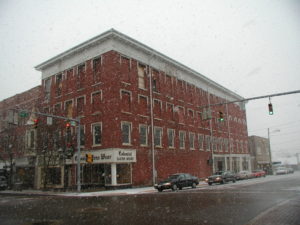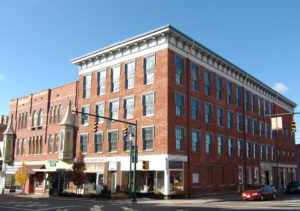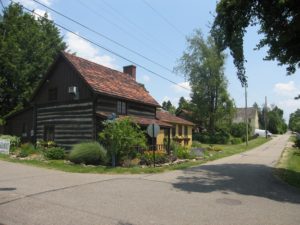(by Andy Sewell, originally posted March 20, 2013)
HDC Continues to Work on the Woodward Opera House
The Woodward Opera House in Mount Vernon, Ohio, is the oldest authentic nineteenth century theatre in the United States; coincidentally, it is also the oldest active project at HDC. It was awarded to HDC in 2000, and company president Charissa Durst says, only partially in jest, that it was because they wanted someone young enough to live through the entire project without becoming senile. In the past 13 years, HDC has renovated two of the first floor retail spaces, added ADA public restrooms, rehabilitated the exterior (masonry, windows, and gutters/downspouts), and rehabilitated the second floor offices. The HDC team is currently working on expanding the existing fire alarm system into the adjacent Cooper Building (aka the “Annex”) to support a local foods market in one of the first floor retail spaces.
From 2011-2012, HDC staff worked feverishly to assist the Woodward Development Corporation in completing a state historic tax credit application for submittal in March 2012. The work paid off and in June 2012 it was announced that the Woodward Opera House was one of 45 projects in Ohio awarded historic preservation tax credits that put empty buildings back into the economic cycle and create jobs through construction activities and reoccupation of the buildings. HDC is currently waiting for official notification of the award of New Market Tax Credits in May/June. The goal is to complete construction on the remaining phases of the project by 2015.
See the project website for additional information: https://thewoodward.org/


The Woodward Opera House: Before the start of renovations and the building today
Hardlines Design Company Participates in Zoar Levee Public Meeting
Hardlines Design Company has been assisting the Huntington District of the U.S. Army Corps of Engineers on preparing a historic properties baseline study as part of the Dam Safety Modification Study (DSMS) for Zoar Levee & Diversion Dam, located in the village of Zoar, Tuscarawas County. The DSMS is required to address performance issues with the levee. HDC is subcontracted to Tetra Tech, Inc., on the project. HDC’s role in the project consists of preparing a detailed cultural history of the Zoar study area; conducting a survey of all above-ground resources in the study area (buildings, ruins, bridges, dams, etc) to assess their historical significance; and constructing archaeological probability models to identify landforms within the study area with potential to hold certain types of archaeological sites.
Zoar Village was founded in 1817 by a group of German Separatists who were seeking a place to freely practice their religion and work together to create a community. Although not initially part of the plan for the settlement, the Separatists voted to pool their interests in the face of harsh economic conditions and a challenging environment, and became a communal society. The village prospered for much of the 19th century, but pressures from both within and outside the community finally resulted in a vote to dissolve the communal system in 1898. Since then, Zoar Village has remained a small, rural community, retaining a surprisingly high degree of historical buildings in good condition, while also managing to keep out most modern development, helping to retain the historic character of the community. This lack of modern development is partially attributable to the construction of Zoar Levee & Diversion Dam in the late 1930s, protecting the village from flooding, with the side effect of also discouraging modern intrusions, due to how the levee is sited on the local topography.
Part of our work with Huntington District included participating in meetings with project stakeholders and the general public to provide an update on progress and solicit important information about the study area that may be known to local residents, but not recorded in any documents. A set of these meetings were held March 6–7, 2013, at New Philadelphia and Zoar. Overall, HDC’s efforts in preparing the historic property baseline study have been well-received. Jennifer Sandy of the National Trust for Historic Preservation called our report “fascinating reading” and project manager Andy Sewell was interviewed at the public meeting for WKSU public radio. Zoar residents are keenly interested in the history of their community, and the historic properties baseline study should be a valuable resource to their research efforts, as well as serving Huntington District as an essential planning tool for addressing the future of Zoar Levee.

A typical streetscape in Zoar, Ohio
Donut the Beagle Is 9 Years Old on March 26!
It’s hard to believe, but the “Little Monster” is going to be 9 years old at the end of the month! Donut came to office on Friday, May 21, 2004, when she was 8 weeks old, which makes her birthday Friday, March 26, 2004. Recently, HDC staff came across a recruiting video for the USDA Beagle Brigade. The video is over 14 minutes long (the opening sequence is hilarious!) and includes tests to determine if your beagle is qualified to join the Brigade. Beagles have to be between the ages 1 and 3 and retire when they are 9 years old, so Donut is now officially a senior citizen. This, however, was not the first time HDC came across the USDA Beagle Brigade.
After Bagle the Beagle came to HDC in 1993, HDC started working with the National Forest Service, a division of the U.S. Department of Agriculture (USDA). It turns out that the USDA has a division called the Beagle Brigade (founded in 1984) to inspect luggage at international airports for food products. HDC then picked up a children’s book called Jackpot of the Beagle Brigade, which was written in 1987. Since Bagle was very calm, balanced, and highly food motivated, HDC staff thought she would have made a good member of the Beagle Brigade. Bagle, however, did not like crowds and probably would not have passed that portion of the test.
Donut likely would never have made it past Test #1, which includes having a stranger pull her tail. One of Donut’s early trainers said that we could only “manage” her quirks, not cure them. Everyone at HDC knows that Donut is tense, nervous, and very sensitive, so we leave her alone when she’s eating, do not accidentally sneak up on her from behind, and definitely do not pull her tail. On the other hand, she can be very friendly, responds immediately to her name, and will obey commands to sit, stay, lay down, and, an office favorite, play dead upon hearing the word “Bang!”

BANG!

